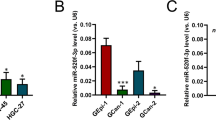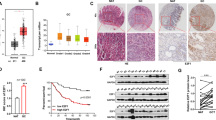Abstract
Emerging evidence has shown that aberrantly expressed microRNAs (miRNAs) are highly associated with tumour development and progression. However, little is known about the potential role of miRNAs in gastric cancer (GC) metastasis. In this study, miR-409-3p was found to be downregulated frequently in human GCs, and its expression was significantly associated with tumor-node-metastasis (TNM) stage and lymph node metastasis. Enforced expression of miR-409 in GC cells significantly reduced their migration and invasion in vitro and their capacity to develop distal pulmonary metastases and peritoneal dissemination in vivo. Moreover, we found that miR-409 exerted its function predominantly through the mature miR-409-3p, but not miR-409-5p. Microarray and bioinformatics analysis identified the pro-metastatic gene radixin (RDX) as a potential miR-409-3p target. Further studies confirmed that miR-409-3p suppressed the expression of RDX by directly binding to its 3′-untranslated region. Silencing of RDX by small interfering RNAs phenocopied the effects of miR-409 overexpression, whereas restoration of RDX in miR-409-overexpressed GC cells reversed the suppressive effects of miR-409. Taken together, these results demonstrate that miR-409 suppresses GC cell invasion and metastasis by directly targeting RDX and that patients with downregulated miR-409-3p are prone to lymph node metastasis.
This is a preview of subscription content, access via your institution
Access options
Subscribe to this journal
Receive 50 print issues and online access
$259.00 per year
only $5.18 per issue
Buy this article
- Purchase on SpringerLink
- Instant access to full article PDF
Prices may be subject to local taxes which are calculated during checkout






Similar content being viewed by others
References
Kamangar F, Dores GM, Anderson WF . Patterns of cancer incidence, mortality, and prevalence across five continents: defining priorities to reduce cancer disparities in different geographic regions of the world. J Clin Oncol 2006; 24: 2137–2150.
Hohenberger P, Gretschel S . Gastric cancer. Lancet 2003; 362: 305–315.
Cappetta A, Lonardi S, Pastorelli D, Bergamo F, Lombardi G, Zagonel V . Advanced gastric cancer (GC) and cancer of the gastro-oesophageal junction (GEJ): focus on targeted therapies. Crit Rev Oncol Hematol 2011 (doi:10.1016/j.critrevonc.2010.12.006).
Deng J, Liang H, Sun D, Pan Y . The prognostic analysis of lymph node-positive gastric cancer patients following curative resection. J Surg Res 2010; 161: 47–53.
Li QL, Ito K, Sakakura C, Fukamachi H, Inoue K, Chi XZ et al. Causal relationship between the loss of RUNX3 expression and gastric cancer. Cell 2002; 109: 113–124.
Oue N, Hamai Y, Mitani Y, Matsumura S, Oshimo Y, Aung PP et al. Gene expression profile of gastric carcinoma: identification of genes and tags potentially involved in invasion, metastasis, and carcinogenesis by serial analysis of gene expression. Cancer Res 2004; 64: 2397–2405.
Stock M, Otto F . Gene deregulation in gastric cancer. Gene 2005; 360: 1–19.
Lagos-Quintana M, Rauhut R, Lendeckel W, Tuschl T . Identification of novel genes coding for small expressed RNAs. Science 2001; 294: 853–858.
Bartel DP . MicroRNAs: genomics, biogenesis, mechanism, and function. Cell 2004; 116: 281–297.
Ambros V . The functions of animal microRNAs. Nature 2004; 431: 350–355.
Calin GA, Croce CM . MicroRNA signatures in human cancers. Nat Rev Cancer 2006; 6: 857–866.
Kent OA, Mendell JT . A small piece in the cancer puzzle: microRNAs as tumor suppressors and oncogenes. Oncogene 2006; 25: 6188–6196.
Wang J, Wang Q, Liu H, Hu B, Zhou W, Cheng Y . MicroRNA expression and its implication for the diagnosis and therapeutic strategies of gastric cancer. Cancer Lett 2010; 297: 137–143.
Wu WK, Lee CW, Cho CH, Fan D, Wu K, Yu J et al. MicroRNA dysregulation in gastric cancer: a new player enters the game. Oncogene 2010; 29: 5761–5771.
Tie J, Pan Y, Zhao L, Wu K, Liu J, Sun S et al. MiR-218 inhibits invasion and metastasis of gastric cancer by targeting the Robo1 receptor. PLoS Genet 2010; 6: e1000879.
Takei Y, Takigahira M, Mihara K, Tarumi Y, Yanagihara K . The metastasis-associated microRNA miR-516a-3p is a novel therapeutic target for inhibiting peritoneal dissemination of human scirrhous gastric cancer. Cancer Res 2011; 71: 1442–1453.
Li Y, Vandenboom II TG, Wang Z, Kong D, Ali S, Philip PA et al. miR-146a suppresses invasion of pancreatic cancer cells. Cancer Res 2010; 70: 1486–1495.
Liang S, He L, Zhao X, Miao Y, Gu Y, Guo C et al. MicroRNA Let-7f inhibits tumor invasion and metastasis by targeting MYH9 in human gastric cancer. PLoS One 2011; 6: e18409.
Ueda T, Volinia S, Okumura H, Shimizu M, Taccioli C, Rossi S et al. Relation between microRNA expression and progression and prognosis of gastric cancer: a microRNA expression analysis. Lancet Oncol 2010; 11: 136–146.
Valastyan S, Reinhardt F, Benaich N, Calogrias D, Szasz AM, Wang ZC et al. A pleiotropically acting microRNA, miR-31, inhibits breast cancer metastasis. Cell 2009; 137: 1032–1046.
Yu H, Zhang Y, Ye L, Jiang WG . The FERM family proteins in cancer invasion and metastasis. Front Biosci 2011; 16: 1536–1550.
Doench JG, Sharp PA . Specificity of microRNA target selection in translational repression. Genes Dev 2004; 18: 504–511.
Grimson A, Farh KK, Johnston WK, Garrett-Engele P, Lim LP, Bartel DP . MicroRNA targeting specificity in mammals: determinants beyond seed pairing. Mol Cell 2007; 27: 91–105.
Kanaan Z, Qadan M, Eichenberger MR, Galandiuk S . The actin-cytoskeleton pathway and its potential role in inflammatory bowel disease-associated human colorectal cancer. Genet Test Mol Biomarkers 2010; 14: 347–353.
Valastyan S, Chang A, Benaich N, Reinhardt F, Weinberg RA . Concurrent suppression of integrin alpha5, radixin, and RhoA phenocopies the effects of miR-31 on metastasis. Cancer Res 2010; 70: 5147–5154.
Ding J, Huang S, Wu S, Zhao Y, Liang L, Yan M et al. Gain of miR-151 on chromosome 8q24.3 facilitates tumour cell migration and spreading through downregulating RhoGDIA. Nat Cell Biol 2010; 12: 390–399.
Liu C, Kelnar K, Liu B, Chen X, Calhoun-Davis T, Li H et al. The microRNA miR-34a inhibits prostate cancer stem cells and metastasis by directly repressing CD44. Nat Med 2011; 17: 211–215.
Chen ZL, Zhao XH, Wang JW, Li BZ, Wang Z, Sun J et al. microRNA-92a promotes lymph node metastasis of human esophageal squamous cell carcinoma via E-cadherin. J Biol Chem 2011; 286: 10725–10734.
Petrocca F, Visone R, Onelli MR, Shah MH, Nicoloso MS, de Martino I et al. E2F1-regulated microRNAs impair TGFbeta-dependent cell-cycle arrest and apoptosis in gastric cancer. Cancer Cell 2008; 13: 272–286.
Song YX, Yue ZY, Wang ZN, Xu YY, Luo Y, Xu HM et al. MicroRNA-148b is frequently down-regulated in gastric cancer and acts as a tumor suppressor by inhibiting cell proliferation. Mol Cancer 2011; 10: 1.
Tsukamoto Y, Nakada C, Noguchi T, Tanigawa M, Nguyen LT, Uchida T et al. MicroRNA-375 is downregulated in gastric carcinomas and regulates cell survival by targeting PDK1 and 14-3-3zeta. Cancer Res 2010; 70: 2339–2349.
Stacker SA, Achen MG, Jussila L, Baldwin ME, Alitalo K . Lymphangiogenesis and cancer metastasis. Nat Rev Cancer 2002; 2: 573–583.
Tsai KW, Wu CW, Hu LY, Li SC, Liao YL, Lai CH et al. Epigenetic regulation of miR-34b and miR-129 expression in gastric cancer. Int J Cancer 2011; 129: 2600–2610.
Hou J, Lin L, Zhou W, Wang Z, Ding G, Dong Q et al. Identification of miRNomes in human liver and hepatocellular carcinoma reveals miR-199a/b-3p as therapeutic target for hepatocellular carcinoma. Cancer Cell 2011; 19: 232–243.
Li X, Zhang Y, Shi Y, Dong G, Liang J, Han Y et al. MicroRNA-107, an oncogene microRNA that regulates tumor invasion and metastasis by targeting DICER1 in gastric cancer: MiR-107 promotes gastric cancer invasion and metastasis. J Cell Mol Med 2011; 15: 1887–1895.
Hoeflich KP, Ikura M . Radixin: cytoskeletal adopter and signaling protein. Int J Biochem Cell Biol 2004; 36: 2131–2136.
Arpin M, Chirivino D, Naba A, Zwaenepoel I . Emerging role for ERM proteins in cell adhesion and migration. Cell Adh Migr 2011; 5: 199–206.
Liu G, Voyno-Yasenetskaya TA . Radixin stimulates Rac1 and Ca2+/calmodulin-dependent kinase, CaMKII: cross-talk with Galpha13 signaling. J Biol Chem 2005; 280: 39042–39049.
Cui Y, Wu J, Zong M, Song G, Jia Q, Jiang J et al. Proteomic profiling in pancreatic cancer with and without lymph node metastasis. Int J Cancer 2009; 124: 1614–1621.
Ou-Yang M, Liu HR, Zhang Y, Zhu X, Yang Q . ERM stable knockdown by siRNA reduced in vitro migration and invasion of human SGC-7901 cells. Biochimie 2011; 93: 954–961.
Acknowledgements
We are most grateful for Dr T Didier's gifts of the pWPXL, psPAX2 and pMD2.G lenti-virus plasmids.
Author contributions: BZ, LL, YS, and XH designed the experiments, interpreted the data and wrote the manuscript. BZ, LL, SH, LL, DJ and QT performed experiments. RZ and QW conducted the animal experiments. CW, ZL, YZ, XC and CD collected the human samples and clinical data.
Author information
Authors and Affiliations
Corresponding authors
Ethics declarations
Competing interests
The authors declare no conflict of interest.
Additional information
Supplementary Information accompanies the paper on the Oncogene website
Supplementary information
Rights and permissions
About this article
Cite this article
Zheng, B., Liang, L., Huang, S. et al. MicroRNA-409 suppresses tumour cell invasion and metastasis by directly targeting radixin in gastric cancers. Oncogene 31, 4509–4516 (2012). https://doi.org/10.1038/onc.2011.581
Received:
Revised:
Accepted:
Published:
Issue Date:
DOI: https://doi.org/10.1038/onc.2011.581
Keywords
This article is cited by
-
Intercellular adhesion molecule 2 as a novel prospective tumor suppressor induced by ERG promotes ubiquitination-mediated radixin degradation to inhibit gastric cancer tumorigenicity and metastasis
Journal of Translational Medicine (2023)
-
BRF2 is mediated by microRNA-409-3p and promotes invasion and metastasis of HCC through the Wnt/β-catenin pathway
Cancer Cell International (2023)
-
Spectrum of microRNAs and their target genes in cancer: intervention in diagnosis and therapy
Molecular Biology Reports (2022)
-
Plasma Exosomal CircNEK9 Accelerates the Progression of Gastric Cancer via miR-409-3p/MAP7 Axis
Digestive Diseases and Sciences (2021)
-
Identification of potential biomarkers for diagnosis of pancreatic and biliary tract cancers by sequencing of serum microRNAs
BMC Medical Genomics (2019)



